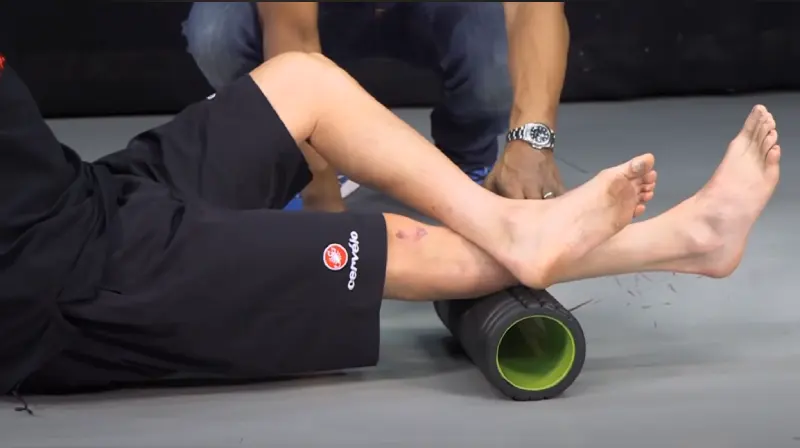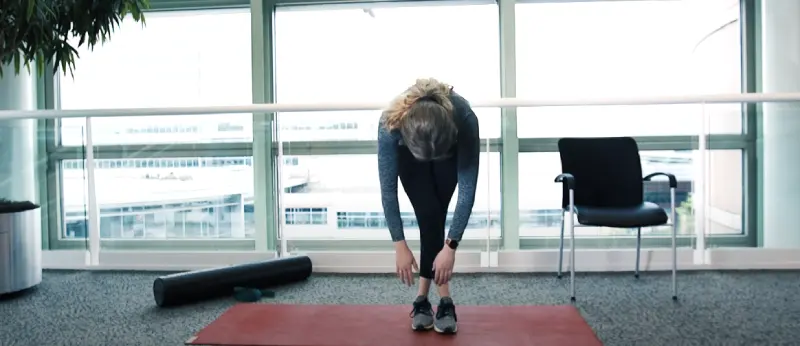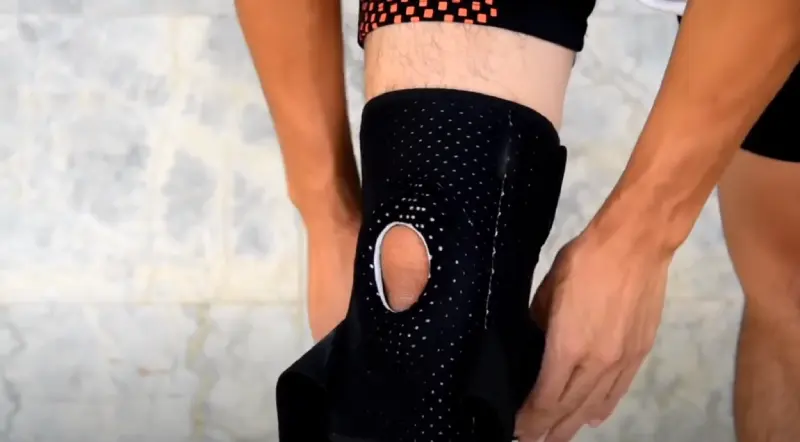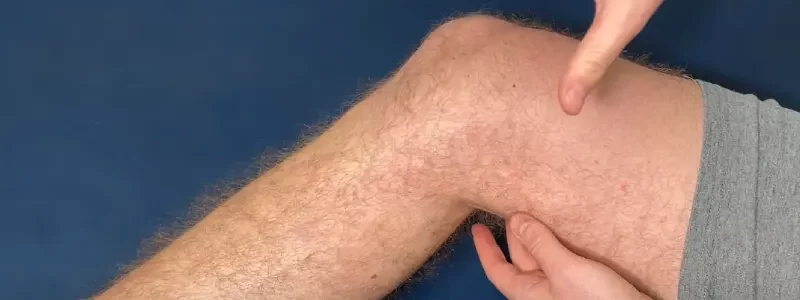Cycling knee pain can be caused by a variety of factors, such as having a saddle that is positioned too low or too far forward, tight hip or knee flexors that compress the patella at the patellofemoral joint, a slow cadence that puts excessive force on the knee, or cleats causing tibial torsion that leads to incorrect patella tracking.
To alleviate knee pain caused by cycling, it is advised to rest and allow your knee cap to adapt to the exerted forces. It may also be beneficial to wear appropriate footwear, apply ice and heat, use a foam roller, consider acupuncture, and explore options such as Botox or cortisone injections.
We will discuss practical ways to treat knee pain and stay healthy while cycling.
How to Treat Knee Pain from Cycling: 9 Recovery Moves

Many avid cyclists experience knee pain at some point, but several ways exist to treat this discomfort and get back on the bike pain-free. We’ll explore different methods of treating cycling knee pain.
Rest
Rest is crucial for treating knee pain from cycling. It allows your body to recover and heal. Cycling puts much stress on your knees, and too much cycling can cause overuse injuries. If you’re experiencing knee pain, rest is essential to help reduce swelling and inflammation.
Recommended Duration of Rest
Your rest period will depend on the severity of your knee pain. If you have a mild injury, a few days of rest should be sufficient. If your knee pain is severe, you may need to take weeks off. Listen to your body and only rush back into cycling once ready.
Exercises to Keep Active While Resting
During rest, low-impact exercises can help keep your muscles active and reduce muscle atrophy. Swimming, walking, and yoga are excellent low-impact exercises that help you stay active without putting additional stress on your knees.
Compression
Compression is an effective treatment for knee pain. This involves using elastic bandages, sleeves, or braces that provide support and reduce swelling. Compression helps stabilize the knee joint and can alleviate discomfort during and after cycling. Applying the compression wrap correctly ensures proper support without restricting blood flow.
Elevation
Elevation is another critical component of knee pain treatment. Elevating the affected leg, especially after a cycling session, can help reduce swelling and promote better circulation. When resting or recovering, prop your leg on a pillow or cushion to keep it above heart level. This position encourages the drainage of excess fluid from the knee, which can contribute to the relief of pain and discomfort.
Wear the Right Shoes
Wearing the right cycling shoes is crucial for preventing knee pain. The right shoes will support and stabilize your feet, reducing the stress on your knees.
Characteristics of the Right Cycling Shoes
The right cycling shoes should have a stiff sole, snug fit, and proper arch support. These shoes help you maintain optimal foot position while cycling and reduce the risk of overpronation.
Tips for Choosing the Right Shoes
- Choose shoes with a snug fit but not too tight.
- Look for shoes with proper arch support.
- Choose shoes with a stiff sole to prevent your feet from bending too much while cycling.
Use Some Ice
Cold therapy reduces inflammation and numbs pain. Applying ice to your knee after cycling helps reduce swelling and inflammation, reducing your recovery time.
Knee Ice: The Correct Method
Towel-wrap a cold pack or bag of ice and apply it to your knee for 10 to 15 minutes.
Time and Frequency of Icing
You should ice the knee for 10-15 minutes, 3 to 4 times daily, until the swelling and pain reduce.
Apply the Heat
Heat therapy improves blood flow to your knee, reducing pain and stiffness. Heat can also reduce muscle tension and improve mobility.
Knee Heat Application Methods
You can apply heat using a warm towel, hot water bottle, or heating pad. Place the heat source on the knee for 15 minutes or so.
Treatment Duration and Frequency
Apply heat to your knee for 15 to 20 minutes, 2 to 3 times daily.
Try a Foam Roller

Foam rolling helps reduce muscle tension and knots, which can contribute to knee pain.
How to Use a Foam Roller to Relieve Knee Pain
Place the foam roller under your knee and roll it back and forth over the affected area for about 30 seconds. Repeat this on other tender spots in your leg.
Common Mistakes to Avoid When Foam Rolling
- Roll slowly.
- Don’t roll over bones or joints.
- Don’t foam roll when your knee pain is severe or acute.
Acupuncture
Using acupuncture can help reduce pain and inflammation associated with knee pain. A thin needle is inserted into a specific point on the body.
Acupuncture Session Expectations
During an acupuncture session, the practitioner will insert needles into specific points on your knee and leg. You may feel a slight pinch, but the experience is generally painless.
Acupuncture Frequency and Duration
Your acupuncture sessions depend on your level of pain. Generally, weekly sessions for 6 to 8 weeks are recommended to start. After this, the frequency can be reduced to weekly or biweekly sessions.
Botox Injections
Botox injections, commonly known for their cosmetic use, can also be utilized for medical treatment, including knee pain relief. Here are some things to know about Botox injections for knee pain treatment:
- Botox injections can alleviate the pain caused by overworked or strained muscles by temporarily paralyzing muscles.
- The ideal candidates for Botox injections are those who have knee pain caused by overused or strained muscles but not those suffering from arthritis or other joint conditions.
- Possible risks and side effects of Botox injections may include bruising, swelling, and temporary weakness or numbness of the surrounding muscles.
Cortisone Injections
Cortisone injections are another popular treatment option for knee pain relief caused by cycling. These injections contain a corticosteroid, which helps to reduce inflammation. Here are some key points to know about cortisone injections:
- Cortisone injections reduce inflammation in the knee joint and can help treat conditions such as arthritis, tendonitis, and bursitis.
- The ideal candidates for cortisone injections are those with knee pain caused by inflammation but not those suffering from structural damage or degenerative joint disease.
- Potential risks and side effects of cortisone injections may include infection, bleeding, and temporary pain or swelling at the injection site.
Gluteus Medius Strengthening Exercises
The gluteus medius muscles, located on the side of the hip, play a crucial role in cycling. Strengthening these muscles can help to alleviate knee pain and improve overall cycling performance. Here are two practical exercises to strengthen the gluteus medius muscles:
- Side-lying leg lifts: Raise your top leg about 12 inches off the ground. Hold for 2-3 seconds, then lower. Repeat for 10-15 reps on each side.
- Rotating dip: Stand on one foot, with the other behind you and touching the ground. Ensure your back stays straight, then turn your torso to lift your upper arm towards the ceiling. On both sides, repeat 10-15 times.
Lateral Muscle Loosening Strategies

The lateral muscles of the thigh, including the iliotibial band (IT band), can also play a role in knee pain from cycling. Here are four strategies to help loosen tight lateral muscles:
- Lower IT band stretch: Stand with your feet shoulder-width apart and cross one leg behind the other. Lean towards the side with the crossed leg until you feel a bit on the outside of your leg. Repeat on the other side for 15-30 seconds.
- Upper IT band stretch: Cross one foot in front of the other and reach your arm over your head towards the opposite side. Push forward with the crossed foot to stretch your outside leg. Hold for 15-30 seconds and repeat on the other side.
- Massage: With a foam roller or massage ball, apply pressure to the tight lateral muscles to help release tension.
- Trigger points: Gently apply pressure to specific points on your lateral muscles to relieve tension.
Lower Body Strength Training Exercises
Strengthening the lower body can also help alleviate knee pain from cycling. Here are four practical exercises to strengthen the lower body:
- Deadlift: Using a weight that challenges you, bend at the hips and lift the weight off the ground, keeping your back straight. Repeat for 10-15 reps.
- Lunge: Starting from a standing position, step one foot forward and bend at the knee until your back knee touches the ground. Return to standing the other way. For each side, repeat for 10-15 reps.
- Squat: Starting from a standing position, lower your body until your thighs are parallel to the ground. Repeat for 10-15 reps after returning to standing.
- Step-up: Using a step or bench, place one foot on the action and lift your body onto the stage. Return to standing from the other side. Perform 10-15 repetitions a side.
Cycling Exercise for Knee Pain
Cycling serves as both the cause and potential remedy for knee pain. When approached with the proper techniques and exercises, cycling can help strengthen knee muscles and relieve pain. Incorporating specific exercises into your cycling routine helps manage knee pain.
Quadriceps Contractions
Quadriceps contractions are an essential exercise for strengthening the muscles surrounding the knee joint. Perform this exercise with your legs straight out in front of you.
You can tighten your quadriceps by pressing the back of the knees into the floor and holding for a few seconds. Release and repeat for multiple sets, gradually increasing the duration of each contraction over time.
Hamstring Stretches
The hamstrings are crucial in supporting the knee joint during cycling. It’s essential to incorporate hamstring stretches into your routine to maintain flexibility and reduce strain on the knee.
While seated or standing, extend one leg forward and lean forward from the hips to stretch the thigh. After 15-30 seconds, switch to the other leg. Repeat this stretch several times on each leg.
Glute Bridges
Glute bridges effectively strengthen the glutes, hamstrings, and lower back muscles, contributing to better knee support during cycling. Your feet should be flat, and your knees should be bent for a glute bridge.
Make a straight line between your shoulders and knees, then lower back down. Aim for multiple sets of 10-15 repetitions.
Low-Impact Cardio
Incorporating low-impact cardio activities, such as swimming or using an elliptical machine, alongside your cycling routine can provide a well-rounded approach to knee pain management. These activities promote cardiovascular health while reducing the impact on the knees.
By alternating between cycling and low-impact cardio, you can diversify your workout regimen and allow your knees to recover and strengthen.
Treatment For Medical Knee Pain Through Cycling

Cycling is great for staying active and maintaining physical fitness. However, knee pain can hinder some individuals from enjoying cycling. Here are some effective treatment options for managing medical knee pain related to cycling.
Knee Braces
Cycling knee braces can provide additional support to the knee joint, reducing strain and minimizing discomfort. These braces are designed to assist in stabilizing the knee and may help prevent further injury while cycling.
Physical Therapy
Engaging in physical therapy can benefit individuals experiencing knee pain related to cycling. Physical therapists can design customized workouts to strengthen knee muscles, improve flexibility, and promote overall stability. Ultrasound, electrical stimulation, and manual therapy also help manage pain and facilitate healing.
Medications
Some healthcare providers may recommend medications for cycling knee pain. These medications can include over-the-counter pain relievers, NSAIDs for inflammation relief, and prescription medications to address more severe pain or swelling in certain situations.
Injections
When considering treatment for knee pain, your healthcare provider may suggest injections. These injections can include:
- Corticosteroids: Helps reduce inflammation and temporarily relieve pain.
- Hyaluronic acid: Acting as a lubricant and cushion within the joint, hyaluronic acid can aid in reducing discomfort and
promoting joint mobility. - Platelet-rich plasma (PRP): PRP contains concentrated growth factors that may support healing and alleviate knee pain.
Surgical Interventions
An injury that may require surgery doesn’t necessarily have to be treated immediately. Considering nonsurgical rehabilitation and surgical reconstruction, your priorities can help you make an informed decision. Surgery may include the following options:
- Partial knee replacement surgery: Replaces just the damaged part of the knee with an implant.
- Total knee replacement: In this surgery, a replacement knee is placed with an artificial joint or implant.
- Osteotomy: Osteotomy involves reshaping or repositioning of the bones in the knee joint in order to alleviate the
pressure on the damaged area. - Knee arthroscopy: A minimally invasive procedure that allows the surgeon to visualize, diagnose, and treat problems
inside the knee joint using a specialized instrument called an arthroscope. - Knee replacement (arthroplasty): This surgery involves replacing the diseased or damaged knee joint parts with
artificial ones.
Conclusion
Knee pain is a common problem that can make cycling an unpleasant experience. Proper treatment prevents it from causing long-term consequences.
This blog post has shared some practical ways for cyclists to treat knee pain. Treatments are available to help reduce knee pain, from resting and wearing the right shoes to using ice and heat therapy.
Taking preventive measures like warm-up exercises before cycling and accumulating mileage can prevent knee pain from occurring. Always remember that it is essential to seek professional help when experiencing severe pain or discomfort.
FAQs
Can I Cycle with Knee Pain?
Cycling is an excellent choice for individuals experiencing knee pain. It helps alleviate discomfort and strengthens the muscles surrounding the knee, providing joint support and pain reduction. Cycling enhances flexibility and range of motion, further contributing to pain relief.


